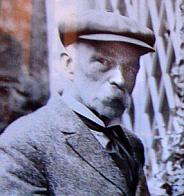Hammond Castle
80 Hesperus Ave.
Gloucester, MA 01930
Sept. 17, 2007
In  our travels we have had occasion to visit
a number of castles across North America. However, one of the most interesting
we have seen (castle as well as owner) was Hammond Castle in Gloucester, MA. Dr.
John Hays Hammond, Jr. built his medieval-style castle between the years 1926
and 1929 to serve both as his home, as a backdrop for his collection of
Roman, medieval, and Renaissance artifacts and as the location for the Hammond
Research Company. The architectural firm of Allen and Collins participated in
the castle's design, later using it as a sort of model after which the Cloisters
in
our travels we have had occasion to visit
a number of castles across North America. However, one of the most interesting
we have seen (castle as well as owner) was Hammond Castle in Gloucester, MA. Dr.
John Hays Hammond, Jr. built his medieval-style castle between the years 1926
and 1929 to serve both as his home, as a backdrop for his collection of
Roman, medieval, and Renaissance artifacts and as the location for the Hammond
Research Company. The architectural firm of Allen and Collins participated in
the castle's design, later using it as a sort of model after which the Cloisters
in  New York was created.
New York was created.
Although the castle was built in the modern times of the twentieth century,
roughly seventy percent of the building is Medieval in nature. Dr. Hammond not
only collected Medieval, Renaissance and Roman art and artifacts, but he also
traveled throughout Europe and Africa collecting pieces of crumbled castle,
churches, monasteries, and shops which were incorporated into his castle. The
castle was given as a wedding present to his wife, Irene  Fenton, and shows her
influence as well. Changes were made to some of the rooms in the courtyard end
of the building which show her tastes the in the Early American style of
furnishings. The courtyard was one of the most interesting areas seen in a
castle. It was built to look like a European village square with small shop
fronts surrounding a central pool area.
Fenton, and shows her
influence as well. Changes were made to some of the rooms in the courtyard end
of the building which show her tastes the in the Early American style of
furnishings. The courtyard was one of the most interesting areas seen in a
castle. It was built to look like a European village square with small shop
fronts surrounding a central pool area.
John Hammond was one of America's
premier inventors, ranking second only to Thomas Alva Edison in the number of
patents credited to him (800 inventions, 540 patents). While his most important work was the development of remote
control via radio waves, which earned him the title, "The Father of Remote
Control" many of his other  inventions were in sound reproduction and
amplification, radio remote control and guidance systems, navigational aids for
ships and aircraft. One of the things that were interesting to me was an early
version of a fifth-wheel that he intended to travel in.
inventions were in sound reproduction and
amplification, radio remote control and guidance systems, navigational aids for
ships and aircraft. One of the things that were interesting to me was an early
version of a fifth-wheel that he intended to travel in.
The Hammond's lived here at the castle until their deaths, Mrs. Hammond's in
1959, and Dr. Hammond's in 1965. As so many other "forward thinkers"
Dr. Hammond specifically stipulated in his will that his castle home was to
become and be maintained as an educational institution. The castle currently
operates under the care of a private non-private organization.
Visitors to the
museum are welcome to explore the castle on a self-guided tour of eight rooms
including the great hall, indoor courtyard, Renaissance dining room, two guest
bedrooms, the inventions exhibit room, the Natalie Hays Hammond exhibit room,
the tower galleries, as well as several smaller rooms and passage ways.
Visitors may also enjoy the beauty of the castle grounds and a view of the
Atlantic shore line. If you are anywhere in the area be sure and set time
aside to visit this "glimpse" into the past.
Good Luck! Have Fun! and Stay Safe!
Laura